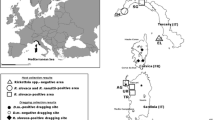Abstract
The authors examine the epidemiologic features of Meditteranean spotted fever in France in light of the bioecological pecularities of each of the three known member of the Rhipicephalus sanguineus tick group (R. sanguineus, R. turanicus, R. pusillus). The results show that R. sanguineus is the main vector. Certain aspects of this tick species are of interest: affinity for man, close contact with humans for a long periods, peak of tick population (preimaginal stages) at the same time as the peak of the disease. The largest populations of R. sanguineus are noted in the endemic zone of human rickettsiosis. The fact that immature stages are more prevalent during the hot season and these forms' ability to bite humans is important and may suggest a role for them in the epidemiology of the disease. The sporadic isolation of this species outside the endemic zone may explain the occurrence of isolated cases of the disease in these areas. We cannot currently exclude vector roles for the two other species, which can parasitize humans, though none of our data supports this hypothesis.
Similar content being viewed by others
References
Boucaut-MaitreY., CloppetH., QueninP. and VincentP. (1985): Etude épidémiologique de Rickettsia conorii dans le Sud-Est de la France. - Acta Medit. Patol. Inf. Trop. 4: 149–153.
De GiallulyE., PayenD., HuetY., PilorgetA., RoujeauJ.L. and RapinM. (1984): Fièvre boutonneuse méditérranéenne contractée en région parisienne. -Press. Med. 13: 506–507.
Desgrippe C. (1986): Les tiques et la fièvre boutonneuse dans le Gard. Thèse Pharmacie (Lyon). 140 p.
DestaingG. (1972): Fièvre boutonneuse en Bourgogne. - Méd. Mal. Infect. 2: 27.
EdlingerE. (1981): Piqûres de tiques et réactions sérologiques para-spécifiques Rickettsia conorii - Arc. Inst. Past. Tunis. 58: 345–358.
Encinas-GrandesA. (1986): Ticks of the Province of Salamanca (Central NW Spain). Prevalence and parasitization intensity in dogs and domestic Ungulates. - Ann. Par. 61: 95–107.
Feldman-MuhsamB. (1952): On the identity of Rhipicephalus sanguineus (Latreille) and R. secundus Feldman-Muhsam in Israel. - Bull. Ent. Res. 47: 43–45.
Feldman-MuhsamB. (1956): The value of the female genital aperture and the peristigmal hairs for diagnosis in the genus Rhipicephalus. - Bull. Res. Counc. Isr. 5: 300–307.
Feldam-MuhsamB. (1986): Ixodic tick attacks on man in Israel: medical implications. - Isr. J. Med. Sci. 1: 19–23.
GalloC., RilliS. and Sobrero L. (1977): Rhipicephalus pusillus Gill Collado, 1938 in Italia. - Riv. Parassit. 38: 89–91.
GilCollado J. (1948): Acaros Ixodoideos de Espana. -Rev. San. Hig. Publ. (Madrid) 22: 389–440.
Gilot B. (1985): Bases biologiques, écologiques et cartographiques pour l'etude des maladies transmises par les tiques (Ixodidae et Argasidae) dans les Alpes française et leur avant-pays. Thèse Doctorat Sciences. Grenoble, 535 p.
GilotB. and MarjoletM. (1982): Contribution à l'étude du parasitisme humain par les tiques (Isodidae et Argasidae), plus particuliérement dans le Sud-Est de la France. - Med. Mal. Infect. 12: 340–351.
GilotB. and PautouG. (1981): Répartition et intérêt épidémiologique de Rhipicephalus turanicus (Pomerantsev, Matikasvili, Lotozki, 1940) (Acarina, Ixodoidea). Ecologie de cette espèce dans le Midi Méditérranéen français. - Ann. Parasit. 56: 547–558.
GilotB., QueninP. and JoubertL. (1981): Recherche de foyers naturels de fièvre boutonneuse dans la basse vallée du Rhône. Hypothèse de travail. Premiers resultats. - Bull. Soc. Sci. Vet et Med. comp. 83: 447–459.
GilotB., PichotJ. and DocheB. (1989): Les tiques du Massif Central (France) 1 les Ixodés (Acariens, Ixodoidea) parasites de Carnivores et d'Ongulés domestiques sur la bordure orientale du Massif. -Acarologia. 3: 191–207.
Herrero-HerreroJ.I., Ruiz-BeltranR., Martin-SanchezA.M. and GarciaE.J. (1989): Mediterranean spotted fever in Salamanca, Spain. Epidemiological Study in patients and serosurvey in animals and Healthy human population. - Acta. Tropica. 46: 335–350.
Lamarque V. (1980): La fièvre boutonneuse méditérranéenne: à propos d'un cas autochtone à Tours, chez un nourrison. These Médecine (Tours). 58 p.
LamontellerieM. (1965): Les tiques (Acarina, Ixodoidea) du Sud-Ouest de la France. - Ann. Parasit. 40: 87–100.
LanotteG., UrvolgyiJ., RiouxJ.A. and JarryD.M. (1981): Le chien dans la rickettsiose méditérranéenne a R. conorii (Brumpt, 1932). - Ann. Parasit. 56: 237–239.
MorelP.C. and VassiliadesG. (1962): Les Rhipicephalus du groupe sanguineus (Acariens: Ixodoidea). - Rev. Elev. Med. Vet. 15: 343–386.
PeterO., BurgdorferW., AeschlimannA. and ChatelanatP. (1984): Rickettsia conorii isolated from Rhipicephalus sanguineus introduced into Switzerland on a pet dog. - Z. Parazitenkd. 70: 265–270.
RagneauJ. (1972): Répartition géographique et rôle pathogène des tiques (Acariens: Argasidae et Ixodidae) en France - Wiad. Parazytol. 18: 707–719.
RaoultD., NicolasD., De Micco Ph., GallaisH. and CasanovaP. (1985): Aspects épidémiologiques de la Fibvre boutonneuse méditérranéenne en Corse du Sud. - Bull. Soc. Path. Exot. 78: 446–451.
RaoultD., TogaB., DunanS., DavoustE. and QuiliciM. (1985): Mediterranean spotted fever in the south of France: serosurvey of dogs. - Trop. Geo. Med. 37: 258–260.
RaoultD. and WalkerD.H. (1990): Rickettsia rickettsii and other spotted fever group rickettsiae (Rocky Mountain Spotted Fever and other spotted fevers) in G.L. Mandell, R.G. Douglas, J.E. Bennett. Principles and Practice of infectious diasease (IIIrd Edition). -Churchill Livingstone. New York. 1465–1470.
RaoulttD., WeillerP.J., ChagnonA., ChaudetH. and CasanovaP. (1986): Mediterranean spotted fever: clinical, laboratory and epidemiological features of 199 cases. - Am. J. Trop. Med. Hyg. 35: 845–850.
Roman E., Lu-Huyng-Thank and Pichot J. (1973): Etude biogéographique et écologique sur les tiques (Acariens, Ixodoidea) de la region lyonnaise. - Bull. Soc. Linn. Lyon. numéro special: 6–73.
SaratsiotisA. and BattelliC. (1975): Rhipicephalus turanicus (Pomerantsev, Matikasvili, Lotozki 1940) en Italic. Comparaison morphologique avec Rhipicephalus sanguineus s. str. - Riv. Parassit. 36: 207–214.
TringaliG., IntonazzoV., PernaV., MansuetoS. and WalkerD.H. (1986): Epidemiology of boutonneuse fever in Western Sicily. Isolation of spotted fever group rickettsiae from Rhipicephalus sanguineus (fam. Ixodidae). - Microbiologica 9: 81–87.
TringaliG., OccinoC., MansuetoS., WalkerD.H. and RaoultD. (1986): Fibvre boutonneuse méditérranéenne diagnostiquée pendant la saison froide. - Med. Mal. Infect. 3: 19–23.
Walter D.H. and Lieth (1960): Klimadiagramme-Weltatlas. (fischer Iéna).
Author information
Authors and Affiliations
Rights and permissions
About this article
Cite this article
Gilot, B., Laforge, M.L., Pichot, J. et al. Relationships between the Rhipicephalus sanguineus complex ecology and mediterranean spotted fever epidemiology in France. Eur J Epidemiol 6, 357–362 (1990). https://doi.org/10.1007/BF00151708
Issue Date:
DOI: https://doi.org/10.1007/BF00151708




